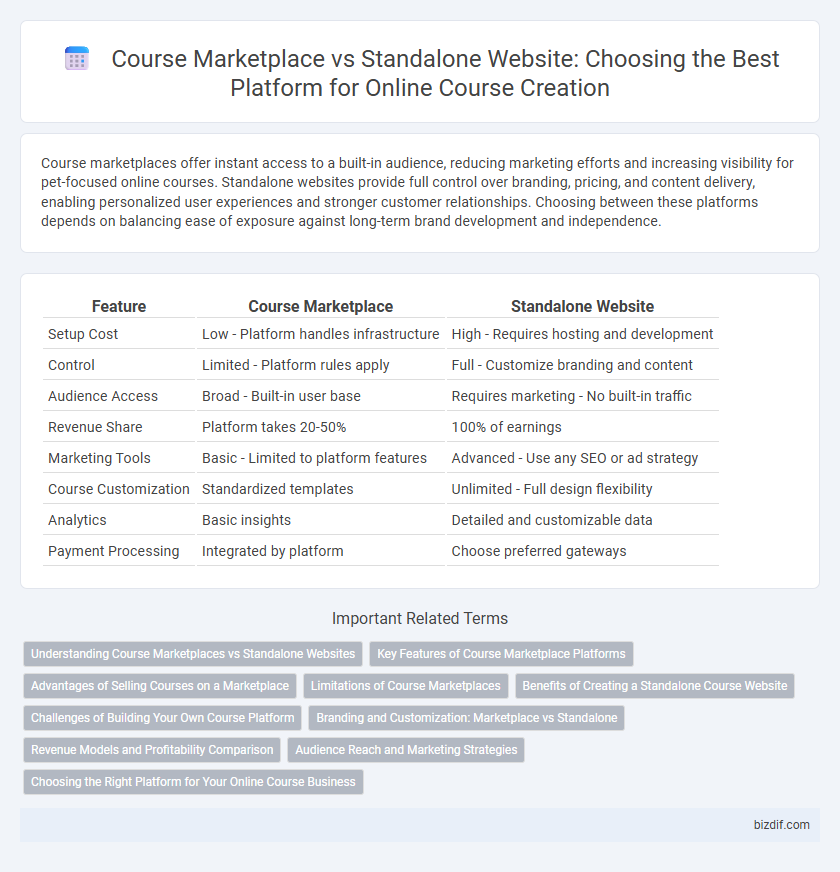Course marketplaces offer instant access to a built-in audience, reducing marketing efforts and increasing visibility for pet-focused online courses. Standalone websites provide full control over branding, pricing, and content delivery, enabling personalized user experiences and stronger customer relationships. Choosing between these platforms depends on balancing ease of exposure against long-term brand development and independence.
Table of Comparison
| Feature | Course Marketplace | Standalone Website |
|---|---|---|
| Setup Cost | Low - Platform handles infrastructure | High - Requires hosting and development |
| Control | Limited - Platform rules apply | Full - Customize branding and content |
| Audience Access | Broad - Built-in user base | Requires marketing - No built-in traffic |
| Revenue Share | Platform takes 20-50% | 100% of earnings |
| Marketing Tools | Basic - Limited to platform features | Advanced - Use any SEO or ad strategy |
| Course Customization | Standardized templates | Unlimited - Full design flexibility |
| Analytics | Basic insights | Detailed and customizable data |
| Payment Processing | Integrated by platform | Choose preferred gateways |
Understanding Course Marketplaces vs Standalone Websites
Course marketplaces like Udemy and Skillshare provide built-in audiences and marketing tools, making it easier to reach potential students quickly. Standalone websites offer full control over branding, pricing, and customer data, crucial for building a unique course identity and long-term business growth. Choosing between marketplaces and standalone sites depends on priorities like immediate reach versus brand ownership and customization flexibility.
Key Features of Course Marketplace Platforms
Course marketplace platforms offer extensive visibility by aggregating diverse courses, enabling creators to tap into established audiences and benefit from built-in payment processing and marketing tools. Key features include centralized user management, integrated review systems, and seamless course discovery through advanced search filters and recommendation algorithms. These platforms also provide community engagement options like discussion forums and social sharing to enhance learner interaction and retention.
Advantages of Selling Courses on a Marketplace
Selling courses on a marketplace offers access to a large, established audience actively searching for learning opportunities, increasing visibility and enrollment potential. Marketplaces handle payment processing, marketing, and customer support, reducing the administrative burden on course creators. The built-in trust and credibility of reputable marketplaces can enhance course sales compared to standalone websites with limited traffic.
Limitations of Course Marketplaces
Course marketplaces often impose strict content guidelines and revenue-sharing models that limit instructor control and earnings potential. They typically restrict customization options, hindering course branding and personalized student experience. Dependency on marketplace algorithms also reduces visibility and long-term audience building compared to standalone websites.
Benefits of Creating a Standalone Course Website
Creating a standalone course website offers complete control over branding, user experience, and pricing strategies, enabling course creators to build a unique and professional online presence. It allows for seamless integration of customized marketing tools, advanced analytics, and customer relationship management systems that boost student engagement and retention. Unlike course marketplaces, a standalone website maximizes revenue potential by eliminating commission fees and fostering direct communication with learners.
Challenges of Building Your Own Course Platform
Building your own course platform requires significant technical expertise to develop user-friendly interfaces, secure payment systems, and reliable hosting infrastructure. Managing ongoing maintenance, software updates, and ensuring compatibility across devices can demand substantial time and financial resources. Marketing and driving traffic without the established audience of course marketplaces poses a critical challenge in gaining visibility and student enrollment.
Branding and Customization: Marketplace vs Standalone
A course marketplace offers limited branding opportunities and standardized templates, restricting customization to maintain platform consistency. In contrast, a standalone website provides full control over branding elements, design, and user experience, enabling creators to build a unique and memorable identity. Optimal customization on standalone sites enhances brand recognition and differentiation in the competitive online education industry.
Revenue Models and Profitability Comparison
Course marketplaces typically charge a commission fee ranging from 20% to 50% per sale, reducing profit margins but providing access to a large audience without upfront marketing costs. Standalone websites require investment in marketing and platform maintenance but enable full control over pricing, subscription models, and promotional strategies, resulting in higher profitability per course sale. Entrepreneurs seeking scalability and brand autonomy often prefer standalone sites despite higher initial costs, whereas marketplaces suit those prioritizing quick market entry and audience reach.
Audience Reach and Marketing Strategies
Course marketplaces offer extensive audience reach by tapping into established user bases on platforms like Udemy or Coursera, benefiting from built-in traffic and brand trust. Standalone websites require targeted marketing strategies such as SEO, email campaigns, and social media advertising to attract and retain learners, offering full control over branding and customer data. Balancing marketplace visibility with personalized marketing efforts on a dedicated site maximizes student acquisition and long-term engagement.
Choosing the Right Platform for Your Online Course Business
Selecting the optimal platform for your online course business hinges on balancing exposure and control; course marketplaces like Udemy offer a vast audience and built-in marketing tools, while standalone websites provide full branding flexibility and direct revenue streams. Marketplaces often charge fees and limit customization, whereas independent sites require more effort in traffic generation but enable tailored user experiences and pricing strategies. Evaluating your business goals, budget, and desired level of independence will guide the choice between leveraging marketplaces' reach or building a personalized, self-hosted course platform.
Course marketplace vs Standalone website Infographic

 bizdif.com
bizdif.com